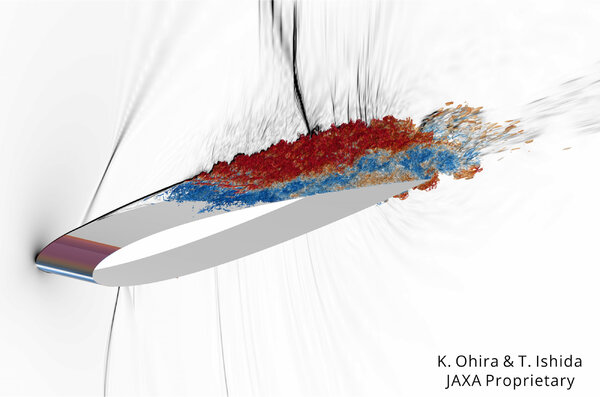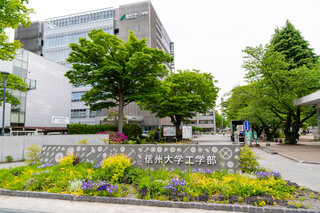About
IUTAM TRANSITION 2024
Transition from laminar to turbulent flow has attracted researchers since the work by Osborne Reynolds at the end of the 19:th century and is still an evolving and vibrant research field, both regarding the nature of various flow instabilities and the relation to the intrinsic mechanisms of turbulence generation as well as being important for many engineering applications. For the advancement of research of turbulence "embryology," nine IUTAM Symposia have so far been held since the first in Stuttgart 1979, followed every five years by Novosibirsk 1984, Toulouse 1989, Sendai 1994, Sedona 1999, Bangalore 2004, Stockholm 2009, Rio de Janeiro 2014 and London 2019. The coming IUTAM Symposium on Laminar-Turbulent transition will be held in 2024 in Nagano, Japan to build on the progress made over the past 45 years. The main topics will be, but not limited to:

- Boundary layer transition
- Flow instability
- Transition in engineering applications
- Control of transition
- Low Reynolds number turbulence or turbulent/laminar flow
- Turbulence generation in transitional and developing turbulent flows
We welcome theoretical, experimental, numerical, as well as AI research on these topics. We are looking forward to your participation and enthusiastic discussions among the participants.

COMMITTEES
Contact address
iutam2024ltt@shinshu-u.ac.jp
Scientific committee
- Yohann Duguet (University Paris-Saclay, France)
- Ardeshir Hanifi (KTH Royal Institute of Technology, Sweden)
- Markus J. Kloker (University of Stuttgart, Germany)
- Masaharu Matsubara (Shinshu University, Japan)
- Marcello A. F. Medeiros (University of São Paulo, Brazil)
- Peter Schmid (King Abdullah University of Science and Technology, Saudi Arabia)
- Tamer Zaki (Johns Hopkins University, USA)
IUTAM Representative
- Jerzy M. Floryan (University of Western Ontario, Canada)
Local committee
- Ayumu Inasawa, secretary (Tokyo Metropolitan University)
- Kentaro Kato, secretary (Shinshu University)
- Genta Kawahara (Osaka University)
- Masaharu Matsubara, chairman (Shinshu University)
- Shoji Sakaue (Osaka Metropolitan University)
- Kosuke Suzuki (Shinshu University)
- Yuji Tasaka (Hokkaido University)
- Naoko Tokugawa (Japan Aerospace Exploration Agency)
Programme
Programme
PLENARY & KEYNOTE SPEAKERS
Plenary Speakers

Rich Kerswell
Rich Kerswell is the G. I. Taylor Professor of Fluid Mechanics at the Department of Applied Mathematics and Theoretical Physics (DAMTP), Cambridge University, UK. After completing his BA at Cambridge, and MA at U.C. Berkeley, he received his PhD in Applied Mathematics from MIT in 1992. Subsequently, he has taught at Newcastle (1992-1996) and Bristol (1996-2017) Universities before moving to Cambridge University in 2017. He has varied scientific interests ranging from geophysical and astrophysical fluid dynamics through granular media and wall-bounded shear turbulence to, most recently, viscoelastic flows.

Marios Kotsonis
Marios Kotsonis is Professor of Flow Control at TU Delft, Department of Flow Physics and Technology. He studied Mechanical Engineering and Aeronautics at University of Patras, Greece and earned his PhD in Aerodynamics at TU Delft in 2012. He is the holder of a 2012 Dutch Research Council Veni award, a 2017 ERC Starting Grant and a 2023 ERC Proof of Concept Grant for his work on the physics and control of swept wing transition. In 2017 he was awarded a Japanese Society for Promotion of Science Postdoctoral fellowship. He is (co-)author of more than 65 journal articles and serves in the editorial advisory board of Experimental Thermal and Fluid Sciences. He is an elected member of the Works Council of his faculty at TU Delft. He currently leads a research team at TU Delft working on a range of topics on boundary layer transition and flow control. Among others, his interests cover plasma-based actuators, advanced flow diagnostics for boundary layers, stability analysis methods, passive and active transition control, and laminar separation.

Pedro Paredes
Dr. Pedro Paredes is a National Institute of Aerospace (NIA) Associate Research Fellow. Dr. Paredes won a NASA Postdoctoral Program Fellowship in 2015 to support the Computational AeroSciences Branch at the NASA Langley Research Center in Hampton, VA, USA, where he continues to work as a NASA contractor. Dr. Paredes earned his Ph.D. and M.Sc. in Aerospace Engineering from the Polytechnic University of Madrid, Spain. He was one of the recipients of the Air Force Office of Scientific Research Young Investigator Award in 2020 and has been awarded with two Office of Naval Research grants as the principal investigator. Dr. Paredes was honored with the American Institute of Aeronautics and Astronautics (AIAA) Associate Fellow distinction in 2024. The research activities of Dr. Paredes are related to boundary layer transition (BLT) prediction and physics-based development of technology concepts for BLT control across the flight speed regimes. He has developed and applied advanced, multidimensional stability-analysis methods for BLT analysis of high-speed flow configurations. Furthermore, Dr. Paredes has co-invented and is developing two novel concepts for BLT control in high-speed boundary layers that promise increased fuel efficiency and reduced environmental impact for supersonic aircraft; and reduced weight of thermal protection system and increased payload for hypersonic vehicles. With a prolific academic record, he has authored over 40 journal articles and 80 conference papers.

Taraneh Sayadi
Mathematical & Numerical Modeling laboratory (M2N)
Conservatoire National des Arts et Métiers (CNAM)
Paris, France
Prof. Sayadi received her PhD from Stanford University at 2012. After which she spend a few years as a postdoctoral researcher in internationally renowned institutions: Ecole Polytechnique, Imperial College London and RWTH-Aachen university. She held a position of Chargée de Recherche (CNRS) at Sorbonne University from 2018-2023. In 2023 she was awarded a Chair Professor Position in “Scientific Computing” at Conservatoire National des Arts et Métiers Paris (CNAM - Paris) and still holds a position of research group leader in the combustion institute at RWTH-Aachen university. Her research interests are in HPC, Data-driven model design and model reduction, and optimization of interfacial and reactive flows.
Keynote Speakers

P. Henrik Alfredsson
P. Henrik Alfredsson obtained his doctoral degree in 1983 from KTH Royal Institute of Technology, Sweden, with a thesis titled “Experimental studies of turbulent channel flow”. He continued research on wall-bounded turbulence but soon focussed on various stability and transition problems, such as turbulent spots in channel flows, and instabilities in plane and curved channel flows under spanwise system rotation. The planning of a new low-turbulence wind tunnel at KTH started in 1986, which he together with his colleague A.V. Johansson inaugurated in 1990 (later named the MTL – Minimum Turbulence Level – wind tunnel). The wind tunnel has among other things been used for studies on Tollmien-Schlichting waves as well as the influence of free-stream turbulence on transition. In 1989, a unique – at that time – plane Couette flow apparatus was designed for the study of turbulent spots and transition to turbulence. Later this apparatus was placed on a rotating table to allow investigations of the influence of the Coriolis force on flow stability and turbulence. Around 2007 he started collaborating with R.J. Lingwood on the stability of flow over rotating disks, which has subsequently expanded to also include the flow over broad and slender cones. Other areas of interest have been wind-turbine wakes, separation flow control, and IC-engine related fluid mechanics. In 1986, he became “extra” professor at KTH, in 1989 full professor in fluid physics and was adjunct professor at II Facolta di Ingegneria, Universita di Bologna between 2007 and 2017. He served as the Dean of the Faculty of KTH between 1999 and 2003 and since 2019 is professor emeritus at KTH. He was elected as a fellow of the American Physical Society, Division of Fluid Dynamics, in 2012. Together with students and colleagues, he has contributed to more than 140 papers in peer-reviewed journals.

Georgios Rigas
Dr. Georgios Rigas is a Senior Lecturer in the Department of Aeronautics at Imperial College London. Before joining IC in 2019, he was a Postdoctoral Scholar at Caltech and the University of Cambridge. He received his Ph.D. in Aeronautical Engineering from Imperial College in 2015. He serves as an early Career member of the PRF editorial board.
His work is focused on the development of techniques to improve the efficiency of fluid-based systems, including wall bounded flows and wakes in transitional and turbulent regimes. He is particularly interested in the development reduced order models, data-driven techniques and the experimental wind tunnel implementation of flow control approaches in real time.
He leads a joint Imperial College-CNRS-ONERA project on Reduced order Modelling using Machine Learning techniques and the Special Interest Group on 'Flow Instability, Modelling, and Control' within the UK Fluid Network. His current work is funded by US AFOSR on the development of transition prediction and control tools for high-speed flows and the UK Research and Innovation (UKRI) on AI for Net Zero.

Daniel Rodríguez
Daniel Rodriguez is Professor at the Department of Applied Mathematics at the School of Aeronautics, Universidad Politecnica de Madrid (UPM), Spain. He graduated as Aerospace Engineer (2007) and PhD in Aerospace Engineering (2010) at UPM, and held postdoctoral positions at California Institute of Technology, University of Sao Paulo, Pontifical Catholic University of Rio de Janeiro and UPM. Was awarded with the European Union's Marie Curie postdoctoral fellowship (2011) and the Brazilian “Science without Borders” postdoctoral fellowship (2014). After holding a faculty position at Fluminense Federal University, he returned to UPM in 2019. He combines theoretical/numerical approaches for the instability analysis of complex flows, numerical simulation and data-driven modeling techniques such as POD and SPOD applied to simulation and experimental data. His main lines of research include instability and transition of boundary-layer and separated flows, modeling and prediction of high-speed jet noise and slat aero-acoustics.

Takahiro Tsukahara
Takahiro Tsukahara is a Professor in the Department of Mechanical and Aerospace Engineering at Tokyo University of Science (TUS). He was born in 1980, and received his PhD in Engineering from TUS in 2007. After working as a Research Fellow of JSPS (Japan Society for the Promotion of Science) and as a visiting researcher at KTH (Royal Institutive of Technology, Sweden), he has been a faculty member in the Department of Mechanical Engineering at TUS, first as an Assistant Professor (2008-2013), later a Lecturer (2013-2017), an Associate Professor (2017-2022), and currently a full Professor (2022-present). In 2011, he was a visiting researcher at the Technical University of Darmstadt. His research employs direct numerical simulations to study subcritical transitions and heat transfers in wall-bounded shear flows of Newtonian and viscoelastic fluids. His main research interests are on flow instability, wall turbulence, drag reduction, elasto-inertial turbulence, scalar transport, interfacial flow, blood flow, and machine learning. He has published more than 60 journal articles. He is the recipient of three Young Scientist Awards from the Heat Transfer Society of Japan, the Japan Society of Mechanical Engineers, and the Japan Association of Computational Mechanics. In addition, he was jointly awarded the Scientific Contribution Award of the Heat Transfer Society of Japan twice in 2020 and 2021.
PRESENTATION GUIDELINES
-
Oral presentation
Each presentation will consist of a 15-minute presentation and an additional 5-minute discussion. Speakers may use their own laptop computer.
Please bring an adapter to connect the laptop to a full-size HDMI. -
Poster presentation
Each poster will be on display in the main room from Sep. 3rd (Tue.) to Sep. 6th (Fri.).
The poster sessions will begin with a three-minute pitch for each poster with one or two slides.-
Poster format
Each presenter is responsible for preparing a poster in A0 size (1189 mm x 841 mm), portrait orientation. Magnets for attaching the posters will be provided by the organizers.
-
Slides for the pitch
Slides should be one or two, with the poster number in the upper left corner of each slide.
Slides will be collected in a folder on a laptop computer provided by the organizer.
We will need your slides by 8:30 am on the day of the poster session so please upload your slides in PDF format to your personal URL specified atof abstract submission.
Please name your pdf file as "Poster number.pdf", for example, "P45.pdf".
-
Poster format
Submission
IMPORTANT DATES & SUBMISSION
IMPORTANT DATES
6th December 2023
Abstract submission opens
15th March 2024 29th February 2024
Deadline of abstract submission is extended to March 15. However <Step 01> needs to be completed by March 8.
30th April 2024
Notification of acceptance
30th June 2024
Early Registration deadline

ABSTRACT SUBMISSION
1. Please read: About process of submitting your abstract
Submission to IUTAM Transition 2024 is a three-step process. Creating a personal account is not required. Instead, it is mandatory to enter your email address at <STEP 01>, which is used to inform you how to upload your PDF abstract in <STEP 02>.
<STEP 01>
Enter information about you (corresponding author), the presentation title and authors on the submission page.
Note that you cannot upload a PDF file of your abstract at <STEP 01>.
<STEP 02>
After <STEP 01>, you will receive an email from the local committee (sender: ltt2024abst@outlook.com) within 48 hours.
The email will contain the personal URL to upload your PDF abstract.
† If you do not receive an email within 48 hours after your completion of <STEP 01>, please contact "ltt2024abst@outlook.com".
<STEP 03>
Upload your PDF abstract to the personally assigned unique URL provided in the email you received at <STEP 02>.
If you wish to update your abstract, please upload the latest version of the PDF to the same URL by the submission deadline.
The committee will consider the latest version of the PDF for review.
[Additional notes]
We strongly recommend that you keep the email received at <STEP 02>.
Do not distribute your personal URL to unknown persons, as it is meant to be a key (in a sense, a password) in itself.
2. Abstract Template
The committee kindly requests that all abstracts are prepared according to the LaTeX template below. Each abstract should not exceed two pages and should be submitted in PDF.
3. Start <STEP 01> for submitting your abstract
Please start your submission on IUTAM Transition2024 Abstract Submission Page.
4. Inquiry
For abstract submission inquiries, please contact ltt2024abst@outlook.com.
PROCEEDING SUBMISSION
Following the theme of previous IUTAM Transition symposia, papers will be published in a conference proceedings by Springer.
Manuscripts should be prepared using the Springer template:
https://resource-cms.springernature.com/springer-cms/rest/v1/content/19338728/data.
Regular papers are up to 6 pages long;
Papers by invited speakers are up to 10 pages.
For details, please refer to the following instructions:
https://resource-cms.springernature.com/springer-cms/rest/v1/content/26362278/data/v1.
Submissions should be made to the online submission system:
https://equinocs.springernature.com/service/iutamtransition2024
The deadline for paper submissions is 22nd November 2024.
Registration
Registration for IUTAM transition 2024
LINK FOR REGISTRATION PAGE
https://amarys-jtb.jp/iutam-2024/
*The registration system is operated by JTB Corp.
RATES FOR SYMPOSIUM PARTICIPANTS
| Early bird registration (until June 30th, 2024 JST) | Regular (after July 1st, 2024 JST) | |
|---|---|---|
| Normal | 64,000 JPY | 70,000 JPY |
| Student | 38,000 JPY | 42,000 JPY |
Note that presenter shoud be registered until June 30th, 2024 (JST).
Normal and Student Registration fee includes
RATES FOR ACCOMPANYING PERSON
| Early bird registration (until June 30th, 2024 JST) | Regular (after July 1st, 2024 JST) |
|---|---|
| 20,000 JPY | 20,000 JPY |
Accompanying person’s Registration fee includes
VISA ASSISTANCE
VISA Inquiries
For those who require VISA to enter to Japan, it is required to complete your registration first and contact JTB Corp., our agency, for the further necessary procedure to apply VISA.
Contact address : visa_support@jbx.jtb.jp
Please note that the fee for visa supporting procedures will be charged 21,780 JPY, which includes consumption tax and agency's handling fee.
Venue
VENUE & TRAVEL
SYMPOSIUM VENUE
Shinshu University, Nagano (ENGINEERING) Campus
Access:
Email:
iutam2024ltt@shinshu-u.ac.jp

The IUTAM transition 2024 symposium will be held in the Nagano (Engineering) Campus of Shinshu University in Nagano City.
ATTRACTIONS IN AND AROUND NAGANO

Matsumoto Castle
Matsumoto Castle is one of only 12 remaining castles in Japan, and when photographed against the backdrop of the Japan Alps, which rises more than 3,000 meters above sea level, it is an insta-spot where you can feel the collaboration of history and nature. It takes 1.5 hours by train or 1 hour by car from the symposium site.

Shinanomachi
Shinanomachi, the birthplace of the haiku poet Kobayashi Issa, is surrounded by the five peaks of "Hokushin-Gogaku" (Mt. Myoko, Mt. Madarao, Mt. Kurohime, Mt. Togakushi, and Mt. Iizuna) and has a typical rural landscape of a Japanese mountain village. It takes one hour by train or 40 minutes by car from the symposium site.
Sponsors
Sponsors









